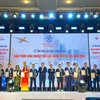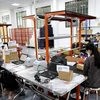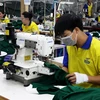The country's textiles and garment sector is seeing a decline in foreign direct investment (FDI) during the past several years, and the sector is being held back by its reliance on imports of raw materials, according to the Vietnam Textile and Apparel Association.
FDI in the sector reached annual average of 460 million USD during the peak period of 2000-08, an decreased in the past three years.
Total registered capital from foreign investors in the sector for 2009 and 2010 was at 185 million USD and 169 million USD respectively. The figure was about 450 million USD last year.
The Vietnam Textile and Apparel Association (Vitas) said FDI capital pumped into the sector remained low due to the negative impacts of the global economic crisis.
Foreign investors also focused heavily on garment making that required low investment capital and out-dated technologies. They paid less attention to the production of raw materials and accessories such as fabrics and processing such as dyeing, that required high investment capital and high technologies and no promise of a quick return on investment, said the association.
Le Quoc An, former chairman of the association, attributed the situation to the fact that Vietnam still lacked industrial zones specialising in fibre, textile and dyeing on large enough scale to attract major overseas companies.
Vietnam earned 14 billion USD from textile and apparel exports last year, but it had to spend up to 9 billion USD on imports of raw materials and accessories.
An said the reliance on imports is the Vietnamese clothing industry's greatest weakness. However, he said it is also a good opportunity for the sector to organise its investment priorities and plan for solid growth in the future.
"Once the sector does this, giant foreign investors will enter Vietnam ," An said.
He added that the participation of the foreign investors in the garment sector, especially since the country adopted more liberal economic policies, had helped Vietnam put its name on the global apparel map and become the 8th largest garment exporter in the world and the 4th largest exporter to the US market.
The major textile and garment investors in Vietnam include the Republic of Korea (RoK), Taiwan , Hong Kong , Japan , Germany and Thailand .
RoK companies have recently made great contribution to the country's clothing exports.
The RoK’s Hansae Co is one of the top ten foreign garment exporters in Vietnam, with export turnover more than 160 million USD during the first five months of this year.
Despite the global economic recession, the company plans to put into operation its third factory in Vietnam , a project worth 30 million USD.
The factory, located at Tan Huong Industrial Zone, in the southern province of Tien Giang , will have an annual production capacity of 30 million clothing products.
The second and first facilities in HCM City and the southern province of Tay Ninh have a combined capacity of more than 70 million products per year.-VNA
FDI in the sector reached annual average of 460 million USD during the peak period of 2000-08, an decreased in the past three years.
Total registered capital from foreign investors in the sector for 2009 and 2010 was at 185 million USD and 169 million USD respectively. The figure was about 450 million USD last year.
The Vietnam Textile and Apparel Association (Vitas) said FDI capital pumped into the sector remained low due to the negative impacts of the global economic crisis.
Foreign investors also focused heavily on garment making that required low investment capital and out-dated technologies. They paid less attention to the production of raw materials and accessories such as fabrics and processing such as dyeing, that required high investment capital and high technologies and no promise of a quick return on investment, said the association.
Le Quoc An, former chairman of the association, attributed the situation to the fact that Vietnam still lacked industrial zones specialising in fibre, textile and dyeing on large enough scale to attract major overseas companies.
Vietnam earned 14 billion USD from textile and apparel exports last year, but it had to spend up to 9 billion USD on imports of raw materials and accessories.
An said the reliance on imports is the Vietnamese clothing industry's greatest weakness. However, he said it is also a good opportunity for the sector to organise its investment priorities and plan for solid growth in the future.
"Once the sector does this, giant foreign investors will enter Vietnam ," An said.
He added that the participation of the foreign investors in the garment sector, especially since the country adopted more liberal economic policies, had helped Vietnam put its name on the global apparel map and become the 8th largest garment exporter in the world and the 4th largest exporter to the US market.
The major textile and garment investors in Vietnam include the Republic of Korea (RoK), Taiwan , Hong Kong , Japan , Germany and Thailand .
RoK companies have recently made great contribution to the country's clothing exports.
The RoK’s Hansae Co is one of the top ten foreign garment exporters in Vietnam, with export turnover more than 160 million USD during the first five months of this year.
Despite the global economic recession, the company plans to put into operation its third factory in Vietnam , a project worth 30 million USD.
The factory, located at Tan Huong Industrial Zone, in the southern province of Tien Giang , will have an annual production capacity of 30 million clothing products.
The second and first facilities in HCM City and the southern province of Tay Ninh have a combined capacity of more than 70 million products per year.-VNA



















